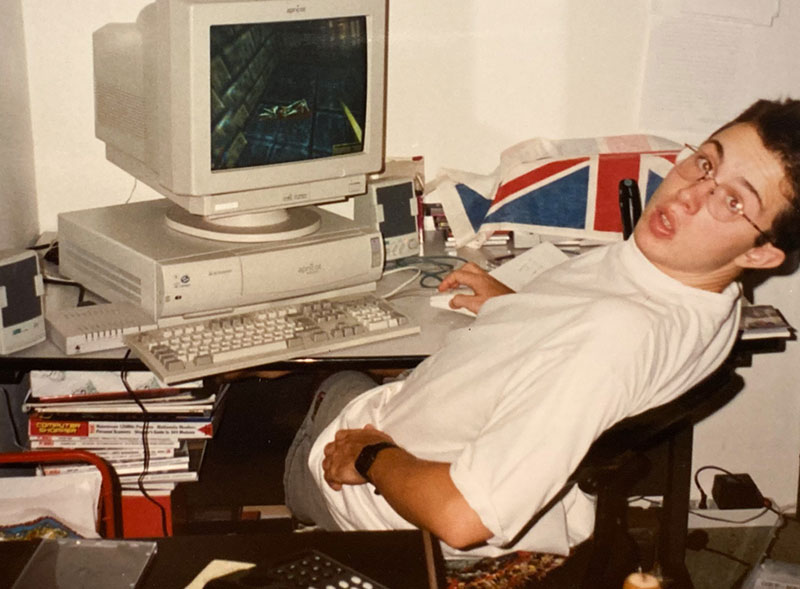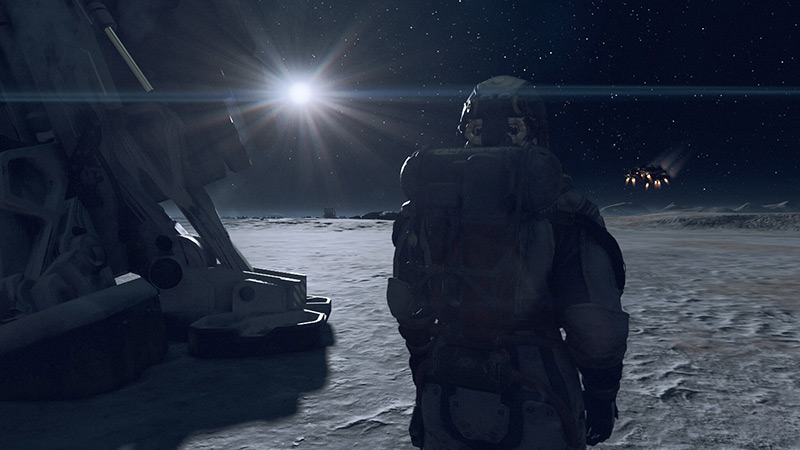Starfield
This is an ongoing post with notes about Starfield, a video game that has been on the top of my pumped-up hype digital play list for a long while. This post will eventually turn into a review about this new 300-years-in-the-future world.
I’ve been playing it live on Twitch and links to past streams on my YouTube channel are below.
HyperTextHero Starfield videos originally streamed live on Twitch:
Around 27 years ago I played a Bethesda Softworks game called Daggerfall and loved it. It felt infinite, with a storyline and quests set in a procedurally-generated world.
Weaving together hand-crafted world and story design with computer-generated data is tricky, and in their following games, starting with Morrowind, the studio began focussing on hand-made game content.
I’ve missed the immensity and random encounters of Daggerfall’s Tamriel, and hope the apparent scale of Starfield (1000 planets) means that procedural generation is back in some form.
Quoting self:
Procedural generation with hand-crafted elements is a holy cup of my favorite drink to quaff while gaming.
When a big group of people like Bethesda workers attempt walking into my video game room holding a giant tray filled with holy cups without crashing, this is something to be celebrated.
My favorite Elder Scrolls game? Daggerfall! Games atop my list of digital wishes? Starfield and The Wayward Realms!

Notes
For the love of the cosmos, please let me press other interface navigation keyboard keys like I to access inventory and V to changee view while in Scanner View mode F.
New gameplay difficulty settings added in the May 2024 patch, particularly enemy and player damage and food/hydration bonuses make the game pace slower and more interesting.
When you die as Starborn the animation shows you becoming stars again. Very nice touch.
Regarding the ending:
I like that it takes you back to the beginning, in a Zen circularity of life way. Another game that has made me think of this is Everything.The inventory user interface (UI) is confusing, and probably my biggest annoyance in the game.
ALL UPPERCASE NAMES FOR ALL ITEMS makes finding something difficult.
Titlecase text for all inventory items would help in a game with so much stuff that you can carry.
The choice of NB Architekt, an ALL-CAPS typeface based on Letraset type from the 60s, for inventory item names is to blame. There are other typefaces in the user interface that have lowercase, such as the one used for item descriptions. Maybe the game can be modded to use them instead.
Better visual indicators for which inventory you are currently in, your avatar’s, or your ship’s, would also help the inventory UI design.
Maybe the ability to pick everything up and subsequent inventory space and weight problems is a commentary on the excesses of human society. No need for 30 dumb bells, 67 trays, and 40 fire extinguishers.
Dialogue options can be funny.
You can turn off bloody continuously-sounding alarms in outposts by finding the switch.
I haven’t finished that questline, yet, but the Grunt Work mission had some interesting environmental storytelling in that slaughterhouse lab where the Terrormorph terrified me, with posters showing the different cuts of meat and blood on the conveyor belts.
This is a game to slow down and go off in a random direction to see what happens, my favorite thing to do in giganto-games like these.
Met Juno, a sentient A.I. Made me think of the importance of spending time alone to know oneself better.
World based on our real universe with Sol and nearby stars, set around 300 years in the future, with references to real human art and history.
Do what you want. No set course. No pre-destination. No destiny. Make your own destiny. Individual versus group. Walk in the forest.
Space. Elite Dangerous education. Losing dad. Escaping to space. Pizza + Elite in Madonna dei Monti in Rome. We are all made of starstuff. Looking at stars in the Brazilian Cerrado’s night sky.
This game needs cooperative play with friends.
Music by Inon Zur, did the soundtrack for Fallout 4 and Crysis.
Nice chunky ship parts design aesthetic.

Graphics have a film-like, cinematic quality to them. Lighting and particles are beautiful, reminding me of the fog in Red Dead Redemption 2. You feel you are moving through gases in an atmosphere, indoors or outdoors. ¶ Landing and exploring the forest area of a planet reminded me how important fast framerates are for my enjoyment of video game where action happens in real time. I fiddled with graphics settings and lowered Render Resolution Scale to 50% for increased Frames Per Second, making the game smooth and enjoyable again.
Sound effects are solid, with boomy low-end bass. The sound mix is excellent overall, especially environmental audio such as the wind on a barren landscape and the beeps, hums, clicks, and whirrs of the vintage computers you find.
The exception is objects you interact with, such as thrown wine glasses, which make very faint sound. These should make loud sounds, like interactive objects in Thief.
The quieter, ambient music I have listened to so far is gorgeous. I didn’t like the main theme as it feels too fast and loud, more like combat music than a song you can hear a lot without getting tired of it. Elden Ring’s main theme has the same problem.
I couldn’t find a setting for the game to not pause and keep playing music when not in focus, which is important for streaming.
Physics feel good, with fairly smooth movement and animations in an engine that can keep track of many objects at once, which is one of the most technically impressive things about the game. Your avatar and enemies stagger and fall according to where they get hit, like crazy student actors in an action drama class, and 0-g combat is tons of fun. ¶ If you jump just short of a ledge your avatar uses her arms to pull herself up. ¶ You can pick up and throw objects by holding E while pointing at them and then pressing R. Unaware enemies don’t seem to be alerted by them falling near them. ¶ Enthusiast tip: After holding E to pick up objects, you can rotate them with right-mouse button, and press Shift once to change the axis of rotation. You can’t seem to pick up and move weapons around. When holding E you equip them. ¶ You can’t use objects that have an obvious use, such as binoculars, but at least you can decorate your starship cockpits :-D ¶ You can sprint, sneak (crouch), and press space bar a second time after jumping to activate a jet pack if you have one and have the skill unlocked.
Artificial Intelligence (A.I.). The variety of responses from humanoid enemies, sometimes charging you, other times waiting and setting up an ambush, or just standing around scared of the rain, make the combat interesting and fun. The speed and freedom of movement given by a jet pack once you find one and unlock the perk in the Tech section of the skill tree makes combat solid and fun.
I like good random events in video games and the exploration gameplay in Starfield has been fun so far.
There are no seamless transitions from space to atmospheric flight like in Star Citizen and No Man’s Sky, nor is there a “glide phase” like in Elite. In fact, you cannot lower the landing gear of your ship. To land, you pick a spot on the planet, press a button, and a cut scene, usually seen from a random angle (good!), shows your ship landing.
You can then travel around an area a few kilometers in size and find points of interest like abandoned outposts and caves. In around 20 hours of play I found an “abandoned listening outpost” with the same exact layout and enemies in two different planets. This has been the most disappointing thing about the game for me thus far, and I hope that AI can help game designers make far more random events in games in the future, though I suspect it will always be a difficult thing to balance.
Keith Burgun, on randomness in game design, specifically, the section on Complexity Effectiveness:
If your game is a continuous series of events that lead deterministically from one to the other, then you are maximizing the amount of unique situations that can occur. I think this idea is counter-intuitive to many, who think that random events occurring somewhere in there must increase the amount of unique situations. However, the opposite is actually the case.
Emily Short, writing about computer-generated content in games:
But to speak for myself: I think the key question in oatmeal-avoidance is whether the generation is connected to anything mechanical. I might be able to generate haiku, or funny food names, or imaginary constellations, or names of funny English-sounding towns, but all that generation is purely decorative unless it is tightly correlated with gameplay — and the player will soon realize that it is decorative and start looking past it.
Character creation is fairly detailed, though not revolutionary. My avatar is called Joan Rambo. I was more impressed with Elden Ring’s, and Elite: Dangerous has more detailed controls for faces. ¶ It is easy to mistakenly move the mouse cursor on top of the previous body feature slider so you change the wrong thing.
Ships are seemingly only flyable in space, and the transition to atmospheric flight happens via a cutscene. I couldn’t open the hatch of my ship to go out for a space walk yet. Not sure if it is blocked in the beginning or not part of the game. ¶ You can freelock around the ship by holding the Q key.ls
The user interface is quite minimal and taking some time for me to get used to. 1st or 3rd person views are available which makes me a happy G.I. Joan dress-up fan, and switching from 1st to 3rd and zoomed-out-3rd person view is easily done with the mouse scroll wheel. ¶ Opening the UI to access your inventory or character traits feels a bit sluggish, with slow transitions. A decent photo mode is present, but keybindings for rotating the camera are needed.
I’m enjoying story so far, and plan on going off in random directions early instead of concentrating on the main quest, which Starfield does seem to allow you to do quite quickly. Dialogue has options useful for avatars with persuasion skills.
Some running commentary over at RPS that I am pasting here for eventual transmelding into the review:
It’s addictive and pushed me to build a new PC to fully enjoy with good framerate!
A good game and framework to build around for something special as the years keep passing by!
Main wishes:
A mod that adds highest-rated player-made points of interest into the procedural generation pool, so you don’t run into the same ones regularly.
PvE multiplayer. This game is a good space to hang out with friends.
Extra vehicular activity. Put the spacewalks back into space games, please!
The ability to fly and land your ship manually in atmospheres.
Buggies, rovers, SRVs, whatever you wish to call them.
After around 30 hours of stream-of-life play, 3 loves and 3 loathes about Starfield:
Loves
- More hopeful near-future game world with Apollo space program vibe.
- Lush sound effects and ambiences, good music.
- Emergent humanoid combat with decent AI and hilarious glitchy physics.
Loathes*
- Inventory management
with no sorting by weight. There is indeed weight sorting (press z a few times on PC).- Seemingly no extra-vehicular activity in space so far. A space game with no space walks!
- Repetition in points of interest. I found an Abandoned Listening Outpost with the same exact layout and enemies in two different planets.
Playing the Premium and enjoying it!
I suspected there’d be no flight through atmospheres from the absence of atmospheric entry footage in the promotional hype, so not too disappointed.
Definitely Fall-Rim in space rather than Elite, NMS, or SC, and that’s okay with me so far.
Combat versus humanoid AI is fun. Inventory weight management is not fun. Currently figuring out how to modify ships to increase cargo space.
…
My favorite thing in the game other than fighting humanoids (and also robots) is sound effects, from single action like the little Plups when you hover over a skill on the skilltree to ambient noises from computers, wind, and so on.
Ambient music is also very good. I think most of the music was done by the person with a minimalist name who did the soundtrack for Crysis.
Thanks for the ship builder tips!
…
I understand the feeling as guns are often loud and can get a bit in the way of a chill time playing.
There are some Fisher Price-like ones like the Solstice laser pistol that while looking more toy-like, sound quite menacing, while regular grey-hardware-type pistols do make a somewhat clickety-clacky sound that is nice to my ears.
By the way, “Solstice” is also the name of a weird NES game I loved. Fallou…I mean, Starfield does seem to have lots of references to video games, and real and fictional classic books, which is nice.
Another niceness: The game seems to have a less apocalyptic view of the future of humankind, despite the seemingly pirate-infested Sol system.
I’m attempting a stealthy build with melee weapons, but at Level 6 my avatar, Joan Rambo, an ex-chef, usually still resorts to firearms to make enemies stop, though the “rescue” axe (LOL!) kills are very satisfying!
…
I’m already looking forward to a survival mode mod for Starfield.
They got the weapon combat feel right, alright, with chunky sounds coupled with the let-me-wack-everything physics engine.
Not sure if these are present yet as I have not progressed too far, but I’m hoping for the ability to throw any object at foes for damage, and bows and arrows, slings that can fire items of a certain size like potatoes and onions, and ninjitsu ninja stars with sharp variable Pheeeewssssh! sound effects.
· ˖ ✦ . ˳
Possibly Related:
˳ · ˖
Prior entry: Valheim
Next entry: Quick Remedies

